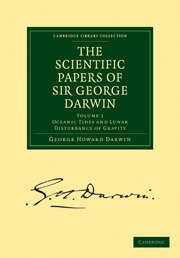Book contents
- Frontmatter
- PREFACE
- Contents
- Chronological List of Papers with References to the Volumes in which they probably will be contained
- PART I OCEANIC TIDES
- ART. 1 The Harmonic Analysis of Tidal Observations
- ART. 2 On the Periods Chosen for Harmonic Analysis, and a Comparison with the Older Methods by means of Hour-angles and Declinations
- ART. 3 Datum Levels: the Treatment of a Short Series of Tidal Observations and on Tidal Prediction
- ART. 4 A General Article on the Tides
- ART. 5 On the Harmonic Analysis of Tidal Observations of High and Low Water
- ART. 6 On an Apparatus for Facilitating the Reduction of Tidal Observations
- ART. 7 On Tidal Prediction
- ART. 8 On the Correction to the Equilibrium Theory of Tides for the Continents
- ART. 9 Attempted Evaluation of the Rigidity of the Earth from the Tides of Long Period
- ART. 10 Dynamical Theory of the Tides
- ART. 11 On the Dynamical Theory of the Tides of Long Period
- ART. 12 On the Antarctic Tidal Observations of the ‘Discovery’
- PART II THE LUNAR DISTURBANCE OF GRAVITY
- INDEX
- Plate section
ART. 5 - On the Harmonic Analysis of Tidal Observations of High and Low Water
Published online by Cambridge University Press: 07 September 2010
- Frontmatter
- PREFACE
- Contents
- Chronological List of Papers with References to the Volumes in which they probably will be contained
- PART I OCEANIC TIDES
- ART. 1 The Harmonic Analysis of Tidal Observations
- ART. 2 On the Periods Chosen for Harmonic Analysis, and a Comparison with the Older Methods by means of Hour-angles and Declinations
- ART. 3 Datum Levels: the Treatment of a Short Series of Tidal Observations and on Tidal Prediction
- ART. 4 A General Article on the Tides
- ART. 5 On the Harmonic Analysis of Tidal Observations of High and Low Water
- ART. 6 On an Apparatus for Facilitating the Reduction of Tidal Observations
- ART. 7 On Tidal Prediction
- ART. 8 On the Correction to the Equilibrium Theory of Tides for the Continents
- ART. 9 Attempted Evaluation of the Rigidity of the Earth from the Tides of Long Period
- ART. 10 Dynamical Theory of the Tides
- ART. 11 On the Dynamical Theory of the Tides of Long Period
- ART. 12 On the Antarctic Tidal Observations of the ‘Discovery’
- PART II THE LUNAR DISTURBANCE OF GRAVITY
- INDEX
- Plate section
Summary
Introduction.
Extensive use of the tide-gauge has only been made in recent years, and by far the largest number of tidal records consist only of observations of high and low water (H. and L. W.). Such observations have usually been reduced by determining the law governing the relationship between the times and heights of H. and L. W. and the positions of the moon and sun. This method is satisfactory so long as the diurnal inequalities are small, but it becomes both complex and unsatisfactory when the diurnal inequality is large. In such cases the harmonic notation for the tide is advantageous, and as, except in the North Atlantic Ocean, the diurnal inequality is generally considerable, a proper method of evaluating the harmonic constants from H. and L.W. observations is desirable.
The essential difference between the method here proposed and that followed by Laplace and his successors is that they introduced astronomical considerations from the first and applied them to each H. and L.W., whereas the positions of the sun and moon will only be required here at a single instant of time. In their method, the time of moon's transit, and hence the interval, was found for each tide; the age of the moon, and the moon's and sun's parallaxes and declinations were also required. An extensive table from the astronomical ephemeris was thus necessary, and there still remained the classification of heights and intervals according to the age of moon, and two parallaxes, and two declinations. The classification could hardly be less laborious, and was probably less mechanical, than the sorting processes employed below.
- Type
- Chapter
- Information
- The Scientific Papers of Sir George DarwinOceanic Tides and Lunar Disturbance of Gravity, pp. 157 - 215Publisher: Cambridge University PressPrint publication year: 2009First published in: 1907



